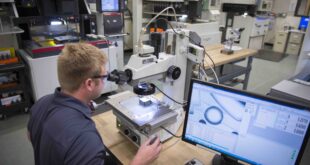Reducing food waste is key to sustainable development and fighting climate change – but meaningful progress will only be possible with collaboration from all actors within global food supply chains. 2D codes could play in tackling the food waste issue by providing more information on food products at the retail and consumer level. Lee Metters reports
Across the globe, enough food is produced to feed 10 billion people, yet hunger and famine still prevail. Each year, around 931 million tonnes of food is wasted following production and processing; of this, 569 million tonnes (61%) is consumer waste, and 118 million tonnes (13%) comes from retail1.
Sustainable development and fighting climate change are directly related to reducing food waste. As such, the UN Sustainable Development Goals include a target to halve this by 20302 – but all aspects of the value chain will have to invest and play their part if we are to achieve this aim.
Optimising inventory management
2D codes can be instrumental in helping brands to gain more insight into their products and improve customer experience by providing information on goods and services – but the benefits of 2D codes do not stop there.
Unique and batch-level 2D codes can be embedded with information to link physical products to their supply chains, allowing brands to collect and share data, track products, and better manage recalls.
While other connective technologies, including RFID tags, can offer many of the same benefits, 2D codes are one of the most practical solutions available today. Creating and printing 2D codes is cheap and easy, and the technology required for scanning and accessing data is readily available and well-established.
At the retail level, including product expiration data within 2D codes can enable retailers to improve inventory management, by tracking the quantity of sellable stock on the shop floor and in the warehouse. This information can be used to remove items from shelves that are past their expiration date, or indeed prevent items with longer sell- or use-by dates being placed on the shop floor before older produce is sold.
Inventory management can be tedious and time-consuming, but with the help of 2D codes, it can be done faster and more efficiently. It also allows businesses to dynamically adjust the price of specific product batches to incentivise purchasing short-life products and further reduce waste.
What is dynamic pricing?
Dynamic pricing is a retail strategy designed to respond to changes in the market – also known as algorithmic pricing – which involves using an algorithm to calculate the optimal price for a product or service.
Dynamic pricing is often used in ecommerce, with companies reducing prices when demand is low and increasing prices when demand is high. It can also be used to tempt consumers to buy products or services they have viewed but not bought, with a price discount applied to encourage a sale.
In stores where 2D codes are used for stock management and at the point of sale (POS), dynamic pricing can be used to encourage consumers to buy products nearing their expiration date. While a standard, linear barcode will only allow a POS system to retrieve a universal product code (UPC), a 2D code can link to much more granular product information, allowing retailers to adjust prices for specific product batches.
Including batch-level data within scannable POS codes allows retailers to update the prices for specific batches to incentivise purchasing. It’s a win-win from a sustainability, and a profitability perspective – retailers reduce food waste by selling products instead of throwing them away, while boosting profit margins.
In recent years, several retailers – such as Woolworths in Australia3, and Meny in Norway and Denmark4 – have trialled dynamic pricing models through date-containing 2D codes on own-brand produce. Third-party providers have also emerged to offer dynamic pricing infrastructure, including shelf labels and POS systems, such as Wasteless, an Israeli start-up using expiry dates and stock data to calculate the optimal product price in real-time, with product data embedded within a 2D code.
Consumer benefit
The end consumer can also gain from the inclusion of additional information within 2D codes. With dynamic pricing models like those described above, consumers can benefit from more competitive pricing and enjoy discounts on items with a reduced shelf life.
In addition, research suggests that consumers are becoming more au fait with the idea of scanning 2D codes to access product information. A recent study from Cornell University looked at replacing date codes on milk with scannable QR codes that would provide a best before date when scanned by a smartphone. During the two-month study, over 60% of customers purchased milk with the QR code rather than a traditional best before date5.
Equipping products with 2D codes also opens opportunities for further Internet of Things (IoT) applications and integration into smart home systems. Smart fridges and personal assistants equipped with technology to download information on products from a scannable 2D code – or from shopping data obtained directly from the retailer – could use the data to provide a household inventory, meal plans, and waste-saving tips.
This may sound futuristic, but innovative tech companies are already releasing smart home systems to help consumers fight food waste. In 2019, Samsung launched the Family Hub, a smart fridge with a built-in internal camera designed to pick up the best before date from fresh produce and advise when food is approaching its expiration.
Conclusion
As the benefits and relevance of 2D codes become more prevalent throughout the food production supply chain – from manufacturing execution, logistics and traceability, retail stock management, and consumer awareness – the time to act is now.
While the application of this technology may seem still to be in its infancy, the rate of adoption looks set to increase rapidly, to which the amount of investment and innovation bears witness. For retailers and manufacturers yet to think about the role that 2D codes could have in your business, there has never been a better time to invest – the market (and competitors) is undoubtedly moving in this direction.
Lee Metters is Group Business Development Director, Domino Printing Sciences.
1. https://www.weforum.org/agenda/2021/03/global-food-waste-solutions
2. https://www.fao.org/sustainable-development-goals/indicators/1231/en/
3. https://www.gs1ie.org/standards/data-carriers/intelligent-barcodes/case-studies/
4. https://www.matvett.no/bransje/matvett-in-english/expiry-date-included-in-barcode-reduces-food-waste
5. https://news.cornell.edu/stories/2022/06/consumers-embrace-milk-carton-qr-codes-may-cut-food-waste
 Engineer News Network The ultimate online news and information resource for today’s engineer
Engineer News Network The ultimate online news and information resource for today’s engineer

